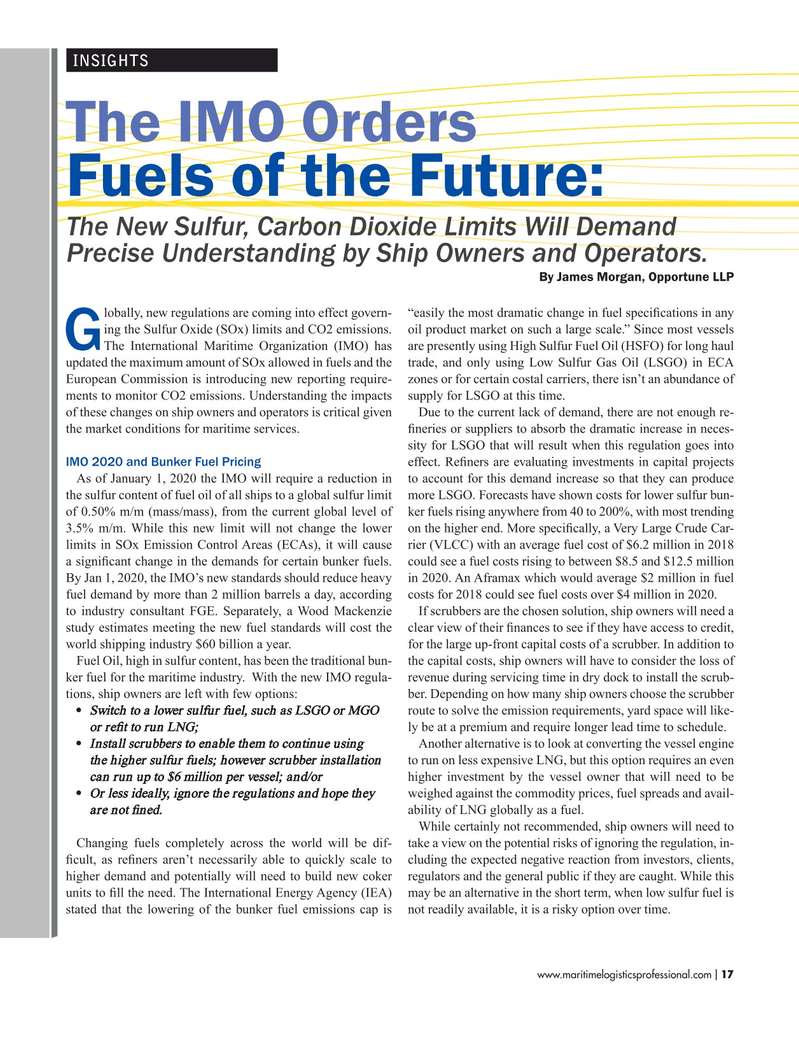
Page 17: of Maritime Logistics Professional Magazine (Sep/Oct 2017)
CONTAINER PORTS
Read this page in Pdf, Flash or Html5 edition of Sep/Oct 2017 Maritime Logistics Professional Magazine
INSIGHTS
The IMO Orders
Fuels of the Future:
The New Sulfur, Carbon Dioxide Limits Will Demand
Precise Understanding by Ship Owners and Operators.
By James Morgan, Opportune LLP lobally, new regulations are coming into effect govern- “easily the most dramatic change in fuel specifcations in any ing the Sulfur Oxide (SOx) limits and CO2 emissions. oil product market on such a large scale.” Since most vessels
GThe International Maritime Organization (IMO) has are presently using High Sulfur Fuel Oil (HSFO) for long haul updated the maximum amount of SOx allowed in fuels and the trade, and only using Low Sulfur Gas Oil (LSGO) in ECA
European Commission is introducing new reporting require- zones or for certain costal carriers, there isn’t an abundance of ments to monitor CO2 emissions. Understanding the impacts supply for LSGO at this time.
of these changes on ship owners and operators is critical given Due to the current lack of demand, there are not enough re- the market conditions for maritime services. fneries or suppliers to absorb the dramatic increase in neces- sity for LSGO that will result when this regulation goes into
IMO 2020 and Bunker Fuel Pricing effect. Refners are evaluating investments in capital projects
As of January 1, 2020 the IMO will require a reduction in to account for this demand increase so that they can produce the sulfur content of fuel oil of all ships to a global sulfur limit more LSGO. Forecasts have shown costs for lower sulfur bun- of 0.50% m/m (mass/mass), from the current global level of ker fuels rising anywhere from 40 to 200%, with most trending 3.5% m/m. While this new limit will not change the lower on the higher end. More specifcally, a Very Large Crude Car- limits in SOx Emission Control Areas (ECAs), it will cause rier (VLCC) with an average fuel cost of $6.2 million in 2018 a signifcant change in the demands for certain bunker fuels. could see a fuel costs rising to between $8.5 and $12.5 million
By Jan 1, 2020, the IMO’s new standards should reduce heavy in 2020. An Aframax which would average $2 million in fuel fuel demand by more than 2 million barrels a day, according costs for 2018 could see fuel costs over $4 million in 2020.
to industry consultant FGE. Separately, a Wood Mackenzie If scrubbers are the chosen solution, ship owners will need a study estimates meeting the new fuel standards will cost the clear view of their fnances to see if they have access to credit, world shipping industry $60 billion a year. for the large up-front capital costs of a scrubber. In addition to
Fuel Oil, high in sulfur content, has been the traditional bun- the capital costs, ship owners will have to consider the loss of ker fuel for the maritime industry. With the new IMO regula- revenue during servicing time in dry dock to install the scrub- tions, ship owners are left with few options: ber. Depending on how many ship owners choose the scrubber • Switch to a lower sulfur fuel, such as LSGO or MGO route to solve the emission requirements, yard space will like- or reft to run LNG; ly be at a premium and require longer lead time to schedule.
• Install scrubbers to enable them to continue using Another alternative is to look at converting the vessel engine the higher sulfur fuels; however scrubber installation to run on less expensive LNG, but this option requires an even can run up to $6 million per vessel; and/or higher investment by the vessel owner that will need to be • Or less ideally, ignore the regulations and hope they weighed against the commodity prices, fuel spreads and avail- are not fned. ability of LNG globally as a fuel.
While certainly not recommended, ship owners will need to
Changing fuels completely across the world will be dif- take a view on the potential risks of ignoring the regulation, in- fcult, as refners aren’t necessarily able to quickly scale to cluding the expected negative reaction from investors, clients, higher demand and potentially will need to build new coker regulators and the general public if they are caught. While this units to fll the need. The International Energy Agency (IEA) may be an alternative in the short term, when low sulfur fuel is stated that the lowering of the bunker fuel emissions cap is not readily available, it is a risky option over time.
www.maritimelogisticsprofessional.com 17
I

 16
16

 18
18
